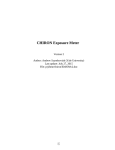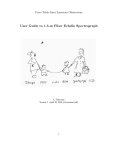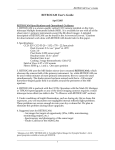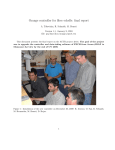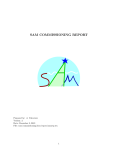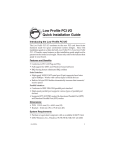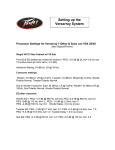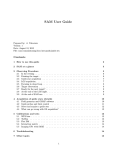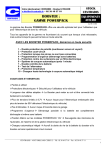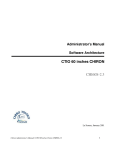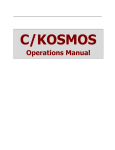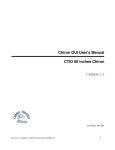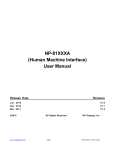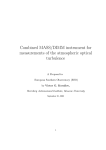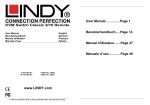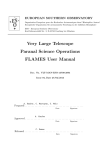Download PDF, 801kB
Transcript
Cerro Tololo Inter-American Observatory CHIRON manual A. Tokovinin Version 2. May 25, 2011 (manual.pdf) 1 1 Overview Fiber Calibration lamps Quartz, Th−Ar Prism Fiber FEM Starlight Guider GAM mirror On the telescope In the coude room Viewer Fiber CCD Focus Image slicer Shutter Iodine cell Spectrograph Figure 1: Light path in CHIRON, from the telescope to the CCD. Elements under user control are pink-colored. CHIRON is a high-resolution fiber-fed echelle spectrometer installed at the CTIO 1.5-m telescope. It can record multi-order echelle spectra of single objects (stars) with spectral resolution up to R = 80 000, 3 pixels per resolution element. The spectral format on the detector is fixed, covering the wavelength range from 4200Å to 8800Å without gaps [TBC]. Figure 1 shows main elements of CHIRON from the user perspective. We follow the path of starlight, directed towards the fiber module (FEM) by a diagonal mirror located in the telescope GAM (at certain position of the pickup arm). The star image is focused on a mirror with a hole; most of the light goes into the fiber, the remaining halo is reflected towards the acquisition/guiding camera. A small prism can be placed behind the mirror to feed calibration light (quartz or Th-Ar lamps) to the spectrometer. The spectrometer is located in the coude room. The light beam emerging from the fiber can be reshaped into a slit-like image by the image slicer, to increase spectral resolution without light loss. The slicer can be moved out of the way to work with bare fiber image (with spectral resolution decreased to R ≈ 30 000) or to mask the fiber by slits (increase the resolution at the expense of light loss). A viewer with manually-activated mirror is used only for troubleshooting, to see the sliced image. Other user-controlled elements are the shutter, iodine cell which can be placed in or out of the beam, and the focusing stage. The CCD is operated by a GUI-driven data-acquisition program. CHIRON is designed to be very stable, its internal environment is maintained at constant temperature. Opening the spectrometer, any other intervention or manipulation are strictly prohibited. To specify observations, astronomer needs to decide whether the image slicer is needed, whether the 2 Table 1: CHIRON parameters Slicer Slicer (R = 80 000) Fiber (R = 30 000) Slits (wide, narrow) Iodine cell IN OUT CCD Normal/Fast readout Binning HxV Region-of-interest iodine cell should be used, and what detector parameters are best suited for the program. Although these choices can be made in any combinations, only a subset of all combinations makes sense. Two observing modes suitable for typical science applications are defined in Table 2. Each program must also specify required calibration data (Th-Ar and quartz spectra, bias frames, etc.). Slits Fiber Slicer Figure 2: Images of the “slit” as seen through the viewer, with fiber illuminated by the quartz lamp. The position of the translation stage defines whether the fiber image is “sliced”, transmitted unchanged or masked by the slits. The slits are not normally used for observations, unless the star is very bright; R = 120 000 can be reached with the narrow slit. Table 2: Basic observing modes Mode Normal Fiber 2 2.1 Slicer Slicer Fiber Binning HxV, speed 3x1, fast 4x4, slow How to use CHIRON CCD parameters The CCD detector is a e2v device with 4096(H)x4112(V) square pixels of 15-micron size, with graded coating. It lives in a dewar cooled by liquid nitrogen, with the Monsoon-Orange controller. Left and 3 right parts of the detector are read with different amplifiers. The gain and readout noise in fast and slow readout modes are listed in Table 3. Table 3: Readout modes of the CCD Mode Normal 1x1 Normal 2x2 Fast 1x1 Fast 2x2 Readout time s 37 14 22 10 Upper-left RON, Gain el el/ADU 4.5 2.39 4.3 2.23 9.6 2.59 7.5 2.53 Upper-right RON Gain el el/ADU 4.2 2.05 4.1 1.92 7.4 2.19 6.1 2.10 The detector response is slightly non-linear. A formula to linearize the measured signal S (in ADU) Scorr = S (1 − kS) (1) leads to the resulting linearity of about 1% at signal level up to 104 ADU, using the non-linearity coefficients k of [4.5, 4.0] × 10−6 in the normal mode and [5.0, 4.3] × 10−6 in the fast mode for the [left,right] amplifiers. It is not recommended to exceed the signal level of 10 000 counts. Echelle dispersion is directed along the columns (vertically), cross-dispersion along the lines. The charge transfer efficiency is very good, about 0.999986 per pixel in the line direction and even better in the column direction. The CCD has minor cosmetic defects. In the left amplifier, there is a charge trap at X=566,567 and Y=3414 (pixel count in the trimmed image), making for two bad columns. In the right half, the most prominent defect is a charge trap at X=2305,2306 and Y=2460 which leaves a dark tail in those two columns below the trap. The tail extends for about 1000 pixels, then disappears. There are two localized detector blemishes at X,Y=(2347, 2526) and (2399, 2516). 2.2 Exposure-time calculator Calculation of the sigmal-to-noise ratio per pixel is based on the following formula: q S/N = Nph / Nph + KR2 (2) where Nph is the number of stellar photons per spectral pixel collected during the exposure time, R is the CCD readout noise in electrons, K is the number of binned pixels across the order. In the normal mode R = 8, K = 9, pixel size is 0.0202Å. In the fiber mode with 4x4 binning and slow readout, R = 4.3, K = 2.5 and the spectral pixel is 4 times larger. The number of photons received during exposure time t is calculated as Nph = F0 ǫ t 10−0.4V [el/pixel] (3) where F0 = 3.4E5 photons/s/pixel is the flux of V = 0m star outside atmosphere per 0.0202Å, ǫ = 0.04 is the total system efficiency, V is source magnitude. These parameters are valid around 500 nm near the center of order in the normal mode. The plots in Fig. 3 were produced using these data. 4 Figure 3: Estimated signal-to-noise ratio at 500 nm vs. exposure time in normal mode with slicer (left) and in the fiber mode (right). The numbers near curves indicate V -magnitude of the source. Figure 4: Snapshot of the PCguider screen during guiding. 5 2.3 Acquisition and guiding The guiding camera is connected to the guiding PC, ctioxb. Use VNC connection to 139.229.12.62:1. In the VNC screen, open the PCguider program from a menu activated by the left mouse button (Fig. 4). In order to see better the star images, use automatic intensity scaling. To do so, use menu in PCguider: Options → Parameters → olut = off (the default is sigma). When the field is illuminated by sky or dome light, dark images of the two holes are seen. The guiding box should be centered on the small hole, normally at X=289, Y=255. You may want to shift the box by ±1 pixel to achieve better centering of the star in the hole. The normal box size is 29 pixels. The North-South direction coincides with Y. After pointing the telescope, the object should be seen on the screen. Adjust camera integration time to avoid saturation (max. counts < 4096). In the PCguider menu, use Windows → Camera Control → Integration Time, set the new value, press Enter. The effect is immediate. In Fig. 4, the integration time is 100 ms. Using hand paddle, move the telescope to bring the star into the box. Most of the image disappears in the hole, and we see a ring (donut), as shown in Fig. 4. The guiding loop can now be closed. To view the image better, adjust the display using its control panel (display menu: Options → Control panel). It is helpful to adjust the contrast and brightness and to use zoom for a larger view of star image in the hole. For focusing the telescope, move the star away from the hole, make sure that the image is not saturated in the camera (max. count < 4096) and in the display. With bad settings of brightness/contrast, the central part of the image looks “flat”, with right settings it is peaked. The position of the guider arm must be checked because the GAM control software systematically goes wrong, so the displayed coordinates of the guide arm do not match its actual position. The correct position should be X = −268, Y = +259, Z = −41. Put a bright star away from the hole, defocus the telescope, and verify that the image is donut-like, not cut on one side. If this is not the case, re-initialize the GAM control program. 2.4 Spectral format The spectral formal is fixed. It covers the wavelength range from 410 nm (start of the bluest order 137) to 874 hm (end of the reddest order 65). Figure 5 shows the spectrum of a F0II star (Canopus) with order numbers and approximate central wavelengths. The order table is listed in the Appendix. Note that the order 109 (517 nm) is right at the center, it is split between two amplifiers. 2.5 Taking spectra CHIRON and its CCD are controlled by the ctioe1 computer. Use VNC connection to 139.229.12.29:9. Read the GUI user manual1 to find out how to operate it. The program controls all CHIRON motors (prism, slicer, iodine cell and focus), calibration lamps, and CCD. The nominal (best) focus setting is 10.24 [TBC]. 1 http://www.ctio.noao.edu/˜atokovin/echelle/CHI60S-1.2 chiron User Manual.pdf 6 70 90 80 110 100 130 120 D1 4239 4207 4371 4405 4304 4146 4271 4439 4337 4510 4176 4547 4475 4621 4698 4660 4860 4903 5125 4819 5034 5079 5269 5319 5370 4584 4738 4989 4778 4946 5172 5474 5537 5582 5638 5935 5220 5421 5695 5753 5812 5873 6128 6197 6264 6633 8556 6480 6062 6407 6793 6876 6961 7048 5998 6335 6712 7137 7228 7322 7723 7517 7418 7831 8054 7941 8674 8542 8415 8291 7619 8171 D2 Hb Hg Ha D1 D2 70 80 90 100 110 120 130 Figure 5: Spectral format of CHIRON covering the range 410–874 nm. Spectrum of Canopus (F0II) in normal mode is displayed in the background (bias-subtracted and trimmed, 4096x4112 pixels). Order numbers are indicated by the scales above and below, some stellar lines in green, approximate central wavelengths of the orders in red. The vertical green line indicates the division between upper-left and lower-right amplifers. 7 70 100 110 4207 4371 4337 4176 4304 4146 4271 4439 4239 4405 4547 120 4510 4698 4660 4475 4621 4819 4860 4903 5125 4584 4738 4989 4778 4946 5172 5079 5269 5319 5370 130 120 5034 5474 5220 5421 5695 5537 5582 5638 6712 5998 5753 6062 5812 6128 5873 6197 90 110 100 6335 6407 8556 6480 6264 7137 6793 6961 80 6633 7048 7418 7517 6876 7322 7723 7228 7619 8171 8291 8415 7831 8054 7941 8674 8542 90 80 5935 70 130 Figure 6: Spectrum of the Th-Ar comparison lamp. 2.6 Checklist • Open the telescope and place the GAM arm at X=-268, Y=+259. • Switch on the FEM electronics on the telescope. • Enter CHIRON GUI, verify that it is connected to the CCD controller, temperature monitor and TSC (green-colored boxes). Take ThAr spectrum. • Check temperatures of the CCD and CHIRON. [Give right values] • Enter the PCGuider program, verify that it acquires the guide-camera images. 2.7 Troubleshooting To be written. Cite software troubleshooting by Marco. 8 A Order table Order numbers N are listed below, with wavelength limits (min,max) corresponding to the free spectral range and central wavelengths. These wavelengths are approximate. # N 65 66 67 68 69 70 71 72 73 74 75 76 77 78 79 80 81 82 83 84 85 86 87 88 89 90 91 92 93 94 95 96 97 98 99 100 Min 8607.5 8477.8 8352.2 8230.3 8111.9 7996.8 7885.0 7776.3 7670.5 7567.5 7467.3 7369.7 7274.6 7182.0 7091.6 7003.5 6917.6 6833.8 6751.9 6672.0 6594.0 6517.8 6443.3 6370.5 6299.3 6229.7 6161.6 6095.0 6029.8 5966.0 5903.6 5842.4 5782.5 5723.8 5666.3 5609.9 Cent 8673.9 8542.5 8415.0 8291.3 8171.1 8054.4 7940.9 7830.6 7723.4 7619.0 7517.4 7418.5 7322.2 7228.3 7136.8 7047.6 6960.6 6875.7 6792.8 6712.0 6633.0 6555.9 6480.5 6406.9 6334.9 6264.5 6195.7 6128.3 6062.4 5997.9 5934.8 5873.0 5812.4 5753.1 5695.0 5638.1 Max 8740.4 8607.2 8477.8 8352.2 8230.3 8111.9 7996.9 7885.0 7776.3 7670.5 7567.5 7467.3 7369.7 7274.6 7182.0 7091.6 7003.5 6917.6 6833.8 6751.9 6672.0 6594.0 6517.8 6443.3 6370.5 6299.3 6229.7 6161.6 6095.0 6029.8 5966.0 5903.6 5842.4 5782.5 5723.8 5666.3 N 101 102 103 104 105 106 107 108 109 110 111 112 113 114 115 116 117 118 119 120 121 122 123 124 125 126 127 128 129 130 131 132 133 134 135 136 Min 5554.6 5500.4 5447.3 5395.2 5344.0 5293.8 5244.6 5196.3 5148.8 5102.2 5056.5 5011.5 4967.4 4924.0 4881.3 4839.5 4798.3 4757.8 4718.0 4678.8 4640.3 4602.4 4565.2 4528.5 4492.4 4456.9 4421.9 4387.5 4353.7 4320.3 4287.4 4255.1 4223.2 4191.8 4160.9 4130.4 9 Cent 5582.2 5527.5 5473.8 5421.2 5369.6 5318.9 5269.2 5220.4 5172.5 5125.5 5079.3 5034.0 4989.4 4945.7 4902.7 4860.4 4818.9 4778.0 4737.9 4698.4 4659.6 4621.4 4583.8 4546.8 4510.5 4474.7 4439.4 4404.7 4370.6 4337.0 4303.9 4271.3 4239.1 4207.5 4176.3 4145.6 Max 5609.9 5554.6 5500.4 5447.3 5395.2 5344.0 5293.8 5244.6 5196.3 5148.8 5102.2 5056.5 5011.5 4967.4 4924.0 4881.4 4839.5 4798.3 4757.8 4718.0 4678.8 4640.3 4602.4 4565.2 4528.5 4492.4 4456.9 4421.9 4387.5 4353.7 4320.3 4287.4 4255.1 4223.2 4191.8 4160.9









